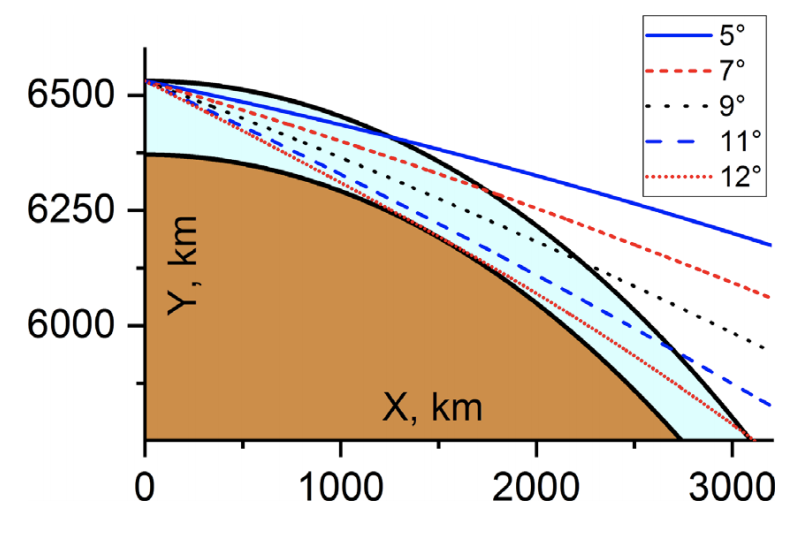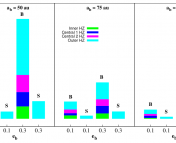Title: On the possibility of through passage of asteroid bodies across the Earth’s atmosphere
Authors: Daniil E. Khrennikov, Andrei K. Titov, Alexander E. Ershov, Vladimir I. Pariev, and Sergei V. Karpov
First Author’s Institution: Siberian Federal University, Krasnoyarsk, Russia
Status: Published in MNRAS [open access]
In the morning of June 30, 1908, a large explosion occurred high in the air above Siberia, Russia. It flattened 80 million trees by one estimate and created a shock wave that measured an equivalent earthquake of magnitude 5.0. The shock wave, in fact, was detected as far away as Washington, D.C. The Tunguska phenomenon, known by some as the Great Siberian Meteor, released so much material into the atmosphere that particles of ice and dust scattered sunlight around the Earth, causing a noticeable glow at night in Europe for days following the explosion.
The Tunguska event is the largest asteroid impact in recorded history and was powerful enough to level a metropolitan area. Thankfully it occurred over one of the most sparsely occupied areas on Earth but that also means very little is known definitively about the circumstances of the asteroid explosion. The authors of today’s paper undertook an exploration of what happens to asteroids as they pass through the Earth’s atmosphere without ever directly contacting the ground, to shed some light on the Tunguska phenomenon.
A Model Asteroid

The type of modeling the authors used for this paper is ballistics. In ballistics modeling, you write an equation of motion, then solve it numerically to see where the object is at each point in its flight. Starting with Newton’s equation of motion, the authors added aerodynamic drag of the asteroid and a variable mass term, since the air melts and strips away the outer edges of the asteroid, reducing its mass as it passes through the atmosphere. They varied the input parameters to see what happens to the asteroid’s trajectory, velocity, and mass over time.
Figure 1 highlights the importance of including variable mass and drag in understanding the motion of a body through Earth’s atmosphere. The dashed line shows the entry angle, α is the bending angle due to mass loss alone and α
is the bending angle due to mass loss and drag. In this model run, it turns out that the mass loss more significantly affects the trajectory than aerodynamic drag.

Given the significance of these two factors, it’s important to find the right values of the drag coefficient and the coefficient of radiative heat transfer (controls mass loss due to sublimation). The authors used a complex hydrodynamic code for this purpose. It works by solving the fluid equations for air flow around an object, which is shown in Figure 2. This was a useful step to get the right coefficient values but the full hydrodynamic code was not used in the main simulations.
Ice or no Ice?
The authors varied a number of parameters in the models they ran: asteroid composition (pure ice, rock, and iron), entry speed, entry angle, and radius. For each combination of parameters, they looked to see how the asteroid loses mass, how its speed varies, and how close it passes to the ground. What they found is that in almost every case, an ice asteroid would be completely destroyed as it passes through the atmosphere, due to sublimation. A rock asteroid could survive a passage through the atmosphere with 10% to 49% mass remaining and an iron asteroid could maintain 8% to 69% of its mass, depending on initial velocity and radius.

One of the most significant parameters is the entry angle. Figure 3 shows trajectories of iron asteroids at five different entry angles, indicating that small variations in the angle result in large variations in the altitude of closest approach.
Challenging the Status Quo
While few people were witness to the largest asteroid impact in recorded history, there are a fair number of estimates in the literature about the altitude, trajectory, and location of the event. The most common story is that a mostly ice asteroid entered the atmosphere at an angle of 30-40º, traveled for 450-700 km and had a closest approach altitude of 10-15 km. The authors of this paper assert that nearly every part of this story is in contradiction with their model findings.
They find that an ice asteroid entering at an angle of 30-40º could hardly travel 300 km before being obliterated. Additionally, it would never make it as close as 15 km to the ground, most likely breaking up somewhere around 40 km above the surface. They considered an ice asteroid passing at lower entry angles (~15º) and found that in those cases, the ice would sublimate even faster, contradicting the travel distance of 450-700 km.
Using a rock or iron asteroid doesn’t immediately resolve these contradictions either. If the asteroid enters at 30-40º, it would likely make it to the ground and leave a large crater, which we know doesn’t exist. In order for any asteroid to have made it down to 10-15 km altitude but not to the surface, the authors find it must have been made of rock or iron and been on a path through the atmosphere and back out to space, which means an entry angle less than 11.5º.
There’s yet another issue with this theory: a rock or iron asteroid would have broken apart gradually and left deposits on the surface, but none have been found. That’s why so many scientists claim it must have been made of ice. The authors explain this by asserting that an iron asteroid would have been sublimated atom by atom, and there’s simply no way to detect extra iron atoms on the surface of Earth.
Contradicting the majority of literature is no simple feat. These authors are steadfast in their finding that the Tunguska asteroid was likely made of iron, not ice, and traveling at a low angle as it entered the atmosphere, later exiting to a different orbit. They hope that these predictions will encourage greater study of this event and redouble efforts to predict near-Earth asteroid encounters.
Cover image credit: The Sun




